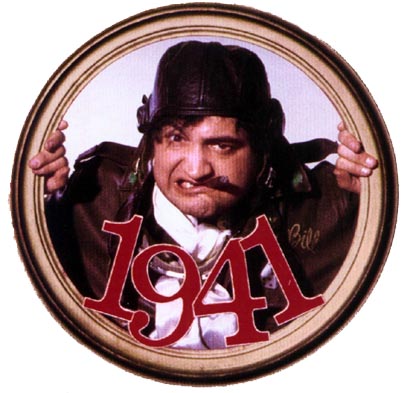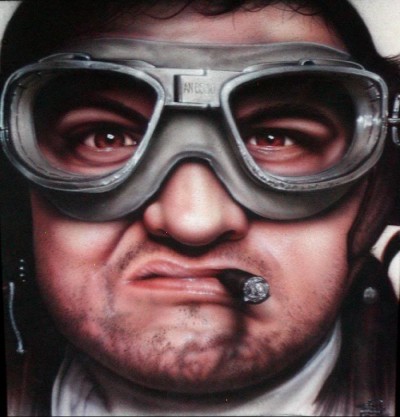 |
[ Outlaw Genealogy | Bruce
History | Lost Chords ] [ Resources | Ufo | [ Projects | News | FAQ | Suggestions | Search | HotLinks ] |
 |
[ Outlaw Genealogy | Bruce
History | Lost Chords ] [ Resources | Ufo | [ Projects | News | FAQ | Suggestions | Search | HotLinks ] |
The Truth About Indochina
- Senator John F. Kennedy,
US Senate, April 6, 1954:
Mr. President, the time has come for the American people to be told the blunt truth about Indochina.
I am reluctant to make any statement which may be misinterpreted as unappreciative of the gallant French struggle at Dien Bien Phu and elsewhere; or as partisan criticism of our Secretary of State just prior to his participation in the delicate deliberations in Geneva. Nor, as one who is not a member of those committees of the Congress which have been briefed--if not consulted--on this matter, do I wish to appear impetuous or alarmist in my evaluation of the situation.
But to pour money, material, and men into the jungles of Indochina without at least a remote prospect of victory would be dangerously futile and self-destructive. Of course, all discussion of “united action” assumes the inevitability of such victory; but such assumptions are not unlike similar predictions of confidence which have lulled the American people for many years and which, if continued, would present an improper basis for determining the extent of American participation.
Despite this series of optimistic reports about eventual victory, every member of the Senate knows that such victory today appears to be desperately remote, to say the least, despite tremendous amounts of economic and materiel aid from the United States, and despite a deplorable loss of French Union manpower. The call for either negotiations or additional participation by other nations underscores the remoteness of such a final victory today, regardless of the outcome at Dien Bien Phu. It is, of course, for these reasons that many French are reluctant to continue the struggle without greater assistance; for to record the sapping effect which time and the enemy have had on their will and strength in that area is not to disparage their valor. If “united action” can achieve the necessary victory over the forces of communism, and thus preserve the security and freedom of all Southeast Asia, then such united action is clearly called for. But if, on the other hand, the increase in our aid and the utilization of our troops would only result in further statements of confidence without ultimate victory over aggression, then now is the time when we must evaluate the conditions under which that pledge is made.
I am frankly of the belief that no amount of American military assistance in Indochina can conquer an enemy which is everywhere and at the same time nowhere, “an enemy of the people” which has the sympathy and covert support of the people.
Moreover, without political independence for the Associated States, the other Asiatic nations have made it clear that they regard this as a war of colonialism; and the “united action” which is said to be so desperately needed for victory in that area is likely to end up as unilateral action by our own country. Such intervention, without participation by the armed forces of the other nations of Asia, without the support of the great masses of the people of the Associated States, with increasing reluctance and discouragement on the part of the French--and,
I might add, with hordes of Chinese Communist troops poised just across the border in anticipation of our unilateral entry into their kind of battleground--such intervention, Mr. President, would be virtually impossible in the type of military situation which prevails in Indochina.
This is not a new point, of course. In November of 1951, I reported upon my return from the Far East as follows:
“In Indochina we have allied ourselves to the desperate effort of a French regime to hang on to the remnants of empire. There is no broad, general support of the native Vietnam government among the people of that area. To check the southern drive of communism makes sense but not only through reliance on the force of arms. The task is rather to build strong native non-Communist sentiment within these areas and rely on that as a spearhead of defense rather than upon the legions of General de Lattre. To do this apart from and in defiance of innately nationalistic aims spells foredoomed failure.”
In June of last year, I sought an amendment to the Mutual Security Act
which would have provided for the distribution of American aid, to the extent feasible, in such a way as to encourage the freedom and independence desired by the people of the Associated States My amendment was soundly defeated on the grounds that we should not pressure France into taking action on this delicate situation; and that the new French government could be expected to make “a decision which would obviate the necessity of this kind of amendment or resolution.” The distinguished majority leader [Mr. Knowland] assured us that “We will all work, in conjunction with our great ally, France, toward the freedom of the people of those states.”
Every year we are given three sets of assurances: First, that the independence of the Associated States is now complete; second, that the independence of the Associated States will soon be completed under steps “now” being undertaken; and, third, that military victory for the French Union forces in Indochina is assured, or is just around the corner, or lies two years off. But the stringent limitations upon the status of the Associated States as sovereign states remain; and the fact that military victory has not yet been achieved is largely the result of these limitations. Repeated failure of these prophecies has, however, in no way diminished the frequency of their reiteration, and they have caused this nation to delay definitive action until now the opportunity for any desirable solution may well be past.
It is time, therefore, for us to face the stark reality of the difficult situation before us without the false hopes which predictions of military victory and assurances of complete independence have given us in the past. The hard truth of the matter is, first, that without the wholehearted support of the peoples of the Associated States, without a reliable and crusading native army with a dependable officer corps, a military victory, even with American support, in that area is difficult if not impossible, of achievement; and, second, that the support of the people of that area cannot be obtained without a change in
the contractual relationships which presently exist between the Associated States and the French
Union.
If the French persist in their refusal to grant the legitimate independence and freedom desired by the peoples of the Associated States; and if those peoples and the other peoples of Asia remain aloof from the conflict, as they have in the past, then it is my hope that Secretary Dulles, before pledging our assistance at Geneva, will recognize the futility of channeling American men and machines into that hopeless internecine struggle.
The facts and alternatives before us are unpleasant, Mr. President. But in a nation such as ours, it is only through the fullest and frankest appreciation of such facts and alternatives that any foreign policy can be effectively maintained. In an era of supersonic attack and atomic retaliation, extended public debate and education are of no avail, once such a policy must be implemented. The time to study, to doubt, to review, and revise is now, for upon our decisions now may well rest the peace and security of the world, and, indeed, the very continued existence of mankind. And if we cannot entrust this decision to the people, then, as Thomas Jefferson once said: “If we think them not enlightened enough to exercise their control with a wholesome discretion, the remedy is not to take it from them but to inform their discretion by education.”
The Truth About Indochina appears courtesy of Utah
County Veterans Council
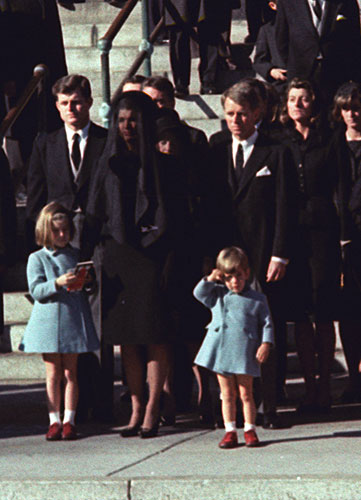
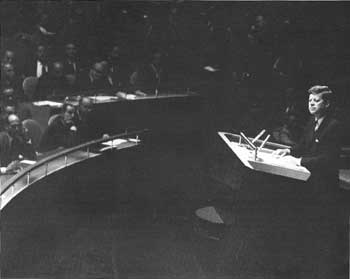 JFK Addresses UN
JFK Addresses UN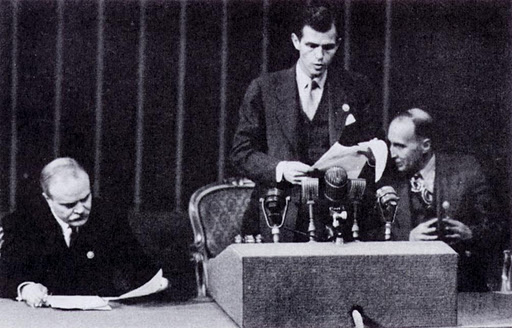 Alger Hiss at UN conference (San Francisco) 1945
Alger Hiss at UN conference (San Francisco) 1945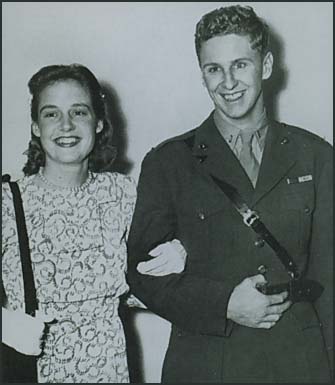
VF-32 Outlaw's Bandits (Est 1 Jun 1943, Dis 13 Nov 1945) (F6F-3/5)
http://www.maam.org/flightsim/news/tbm_langley.htm
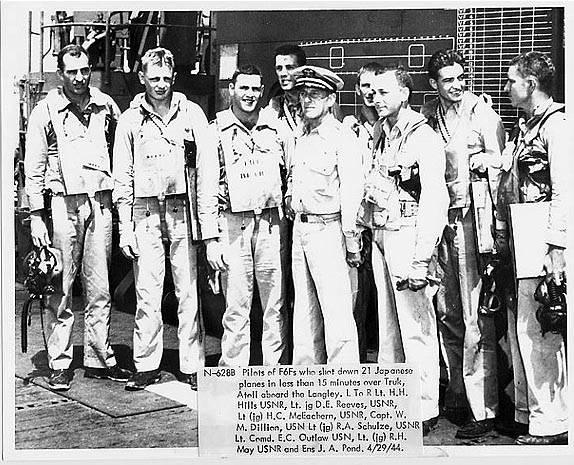
WWII Ace
- Navy Cross -
Cinqpaq Rear Admiral Ed
Cobb Outlaw - tells the truth about Vietnam:
Carriers
in combat the air war at sea - Vietnam - By Chester G. Hearn
Rolling Thunder - Cambodian supply depots off limits - SOVIET
SA-2 SAM sites shot down
115 american planes
"We were restrained to carrying out a campaign which seemed designed NOT
to win" because RUSSIAN technicians might be killed.
McNamara did not allow pilots to attack any installation where MIG's were
based.
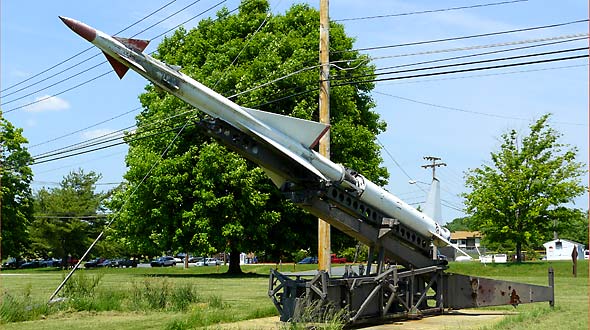 Soviet SA-2 SAM
Soviet SA-2 SAM
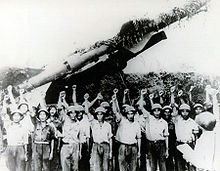
http://en.wikipedia.org/wiki/S-75_Dvina
The S-75 Dvina (Russian: С-75; NATO reporting name SA-2 Guideline) is a
Soviet-designed, high-altitude, command guided, surface-to-air missile (SAM)
system. Since its first deployment in 1957, it has become the most
widely-deployed and -used air defense missile in history
This system first gained fame when an S-75 battery shot down a U-2 overflying
the Soviet Union in 1960. Later, North Vietnamese forces used the S-75
extensively during the Vietnam War to defend Hanoi and Haiphong
...
In 1965 North Vietnam asked for some assistance against the US's airpower, which
they were essentially defenseless against at the time. After some discussion it
was agreed to supply the PAVN with the S-75. The decision was not made lightly,
because it greatly increased the chances that one would fall into US hands for
study. Site preparation started early in the year, and the US detected the
program almost immediately on April 5, 1965. While military planners pressed for
the sites to be attacked before they could become operational, their political
leaders refused, fearing that Soviet technical staff might be killed.[citation
needed]
On July 24, 1965, a USAF F-4C aircraft was shot down by an SA-2.[3] Three days
later, the US responded with Operation Iron Hand to attack the other sites
before they could become operational. Most of the S-75 were deployed around the
Hanoi-Haiphong area and were off-limits to attack (as were local airfields) for
political reasons. President Lyndon Johnson announced on public TV that one of
the other sites would be attacked the next week. The Vietnamese removed the
missiles and replaced them with decoys, while moving every available
anti-aircraft gun into the approach routes. The tactic worked, causing American
casualties.
http://www.vnafmamn.com/Valiant_Anloc.html
It should be noticed that the ARVN ground forces at An Loc have been
armed with the "humble" M-72s (no good for firing at Soviet heavy
battle Tanks, it works only when firing at the right spot and with luck) and
home-made, modified anti-tank "mines." Why? Because at this difficult
phase of Vietnam war, Uncle Sam was in the process of pulling out. No more
Yankee ground troops around, but only the advisory teams. And now, brace
yourselves, you are descending into hell: Battle of An Loc. April 1972
NORTH VIETNAMESE COMMUNISTS' TANKS DESTROYED AROUND AN LOC
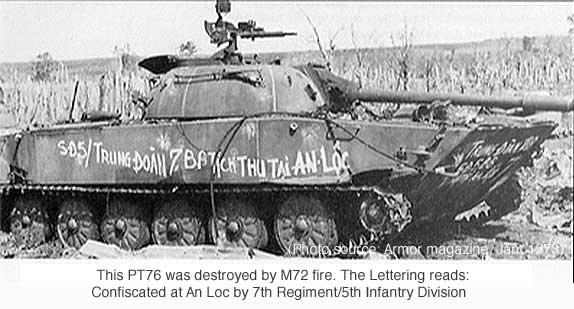
http://www.wellesley.edu/Polisci/wj/Vietimages/nva-tank.html
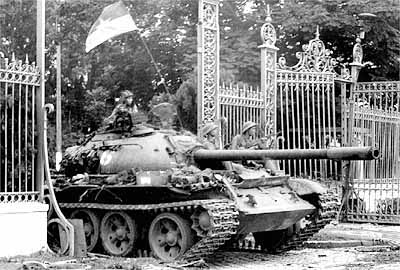
A North Vietnamese tank crashes through the gates of the Presidential Palace in
Saigon on April 30, 1975
http://en.wikipedia.org/wiki/Weapons_of_the_Vietnam_War
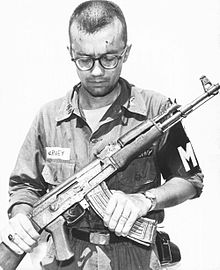
A U.S. Army M.P. inspects a Soviet AK-47 recovered in Vietnam in 1968.
http://ussintrepidfcmassociation.org/intrepidfighteraces.aspx
Outlaw, Edward C., Cdr., VF-32, USS Langley (CVL-27), CO USS Intrepid
(CVA-11) - 6
Born 1914 in Greenville, NC; Public Schools, Goldboro, NC.; USNA '35, Retired,
Durham, NC '69.
Flight Training, Pensacola '37-'38. USS Enterprise, Scouting Squadron 6. '42
deployed to Pacific as XO (VC-11) flying F4F (Wildcats).
Led flight of 54 from Fiji to Guadalcanal to re-enforce Marine Corps. He
served there as leader of the Navy Fighter Group.
'43 formed VF-32 as CO. Deployed on USS Langley .
April 29, '44, he led a flight of 8 Hellcats on a pre-dawn fighter sweep over
Truk atoll; at dawn sighted a flight of aout 36 Japanese Zeroes flying at 10,000
ft in column of V's; first pass his flight flamed 8; then, exercising perfect
discipline "Holly" Hills (4 kills) led his division to "high
cover" where they accounted for seven of the enemy.
Cdr. Outlaw shot down 5 and 1 probable, fellow Ace, Dick May got 3 and Outlaw's
wingman 4.
Total for this brief action was 22 victories and 6 probables.
The action took place in less than ten minutes and was declared by COMNAVAIRPAC
to be "a perfect example of air combat and air discipline."
Subsequently, he served three times in Pentagon; as CO of USS Duxbury Bay and
USS Intrepid; as CO Air Group Six (Coral Sea);
CO Heavy Attack Squadron five (NucWpns).
Selected to rank of Rear Admiral and served as Commander Naval Aviation Safety
Center;
Commander Carrier Division One and Task Force 77 of Vietnam '64-'65 where he
directed first sustained attacks;
Commander CARDIVS 16 and 20 and Commander Hunter-Killer Force, Atlantic Fleet.
His last assignment was as Commander Fleet Aircraft Mediterranean/CTF-67/ and
Maritime Air Mediterranean (a NATO orgnization of which he was the first
commander).
Decorations: Navy Cross, Legion of Merit (3), DFC (3)
http://en.wikipedia.org/wiki/Vietnam_People's_Air_Force
1964-1974 (North Vietnam)
...
The North Vietnamese Air Force (NVAF) received its first jet fighter
aircraft, the MiG-17 in February 1964, but they were initially stationed
at air bases in Communist China, while their pilots were being trained. On
February 3, 1964, the first fighter regiment No. 921 "Sao Do" was
formed (Trung Đoŕn Không Quân Tięm Kích 921), and on August 6 it
arrived from China in North Vietnam with its MiG-17s.[2] On September 7, the No.
923 fighter regiment "Yen The", led by Lt. Binh Bui, was formed. In
May 1965, No. 929 bomber squadron (Đại Đội Không Quân Ném
Bom 929) was formed with Il-28 twin engine bombers. Only one Il-28 sortie was
flown in 1972 against Laotian forces.
The North Vietnamese Air Force's first jet air-to-air engagement with U.S.
aircraft was on April 3, 1965. The NVAF claimed the shooting down of one US Navy
F-8 Crusader, which was not confirmed by US sources, although they acknowledged
having encountered MiGs.[2] Consequently, April 3 became "North
Vietnamese Air Force Day". On April 4 the VPAF (NVAF) scored the first
confirmed victories to be acknowledged by both sides. The US fighter community
was shocked when relatively slow, post-Korean era MiG-17 fighters shot down
advanced F-105 Thunderchief fighters-bombers attacking the Thanh Hoa Bridge. The
two downed F-105s were carrying their normal heavy bomb load, and were not able
to react to their attackers.[2]
In 1965, the NVAF were supplied with supersonic MiG-21s by the USSR which
were used for high speed GCI controlled hit and run intercepts against USAF
strike groups. The MiG-21 tactics became so effective, that by late 1966, an
operation was mounted to especially deal with the MiG-21 threat. Led by
Colonel Robin Olds on January 2, 1967, Operation Bolo lured MiG-21s into the
air, thinking they were intercepting a F-105 strike group, but instead found a
sky full of missile armed F-4 Phantom II Phantoms set for aerial combat. The
result was a loss of almost half the inventory of MiG-21 interceptors, at a cost
of no US losses. The VPAF (NVAF) stood down for additional training after this
setback.
http://www.1stcavmedic.com/jane_fonda.htm
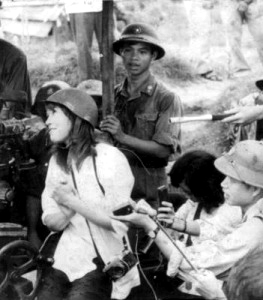 Jane Fonda sitting on an NVA anti-aircraft gun were really her
Jane Fonda sitting on an NVA anti-aircraft gun were really her
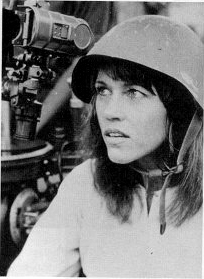
http://www.bibliotecapleyades.net/sociopolitica/sociopol_globalbanking12.htm
The best enemy Money can Buy - Antony Sutton
Americans killed by US made weapons in the Korea and the Vietnam war
“In Korea we have direct killing of Americans with Soviet weapons. The
American casualty roll in the Korean War was 33,730 killed and 103,284
wounded… The 130,000-man North Korean Army, which crossed the South Korean
border in June 1950, was trained, supported, and equipped by the Soviet Union,
and included a brigade of Soviet T-34 medium tanks (with U.S. Christie
suspensions). The artillery tractors were direct metric copies of Caterpillar
tractors. The trucks came from the Henry Ford-Gorki plant or the ZIL plant. The
North Korean Air Force has 180 Yak planes built in plants with U.S. Lend-Lease
equipment. These Yaks were later replaced by MiG-15s powered by Russian copies
of Rolls-Royce jet engines sold to the Soviet Union in 1947.”
...
“Who were the government officials responsible for this transfer of known
military technology? The concept originally came from National Security Adviser
Henry Kissinger, who reportedly sold President Nixon on the idea that giving
military technology to the Soviets would temper their global territorial
ambitions. How Henry arrived at this gigantic non sequitur is not known.
Sufficient to state that he aroused considerable concern over his motivations.
Not least that Henry [Ford] had been a paid family employee of the
Rockefellers since 1958 and has served as International Advisory Committee
Chairman of the Chase Manhattan Bank, a Rockefeller concern.”
“Some years ago research strongly suggested that the Soviets had no indigenous
military transport technology: neither motor vehicles nor marine diesel engines.
Yet about 80 percent of the weapons and supplies for the North Vietnamese
were transported by some means from the Soviet Union. The greater part of these
Soviet weapons went to Vietnam by Soviet freighter and then along the Ho Chi
Minh trail on Soviet-built trucks…
Update: Forgot the Soviet RPG
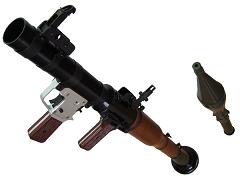
http://vietnamwar-guns.com/shop/product_details.php?p=53
Operating principle: Gas-operated launcher that can fire 6mm BB shot shells,
40mm airsoft/movie prop grenades, nerf-rockets and other types of gaming suited
harmless "soft projectiles".
RPG-7 History
Soviet RPG-7 (or Chicom copy Type-69)was a common multi-purpose heavy weapon
system for NVA and Vietcong who used it in direct firesupport, anti-armour,
anti-helicopter and bunker busting roles.
Soviet RPG-7 was used by VC and NVA from 1967 onwards and was particularly
effective against aluminum hullled M113 APCs. It's main role was, however,
anti-personnel. Easy-to-use, lightweight and powerful RPG-7 and it's variants
are still used world-wide.
All of these weapons were 40mm and capable of penetrating up to 6" of
armour at ranges of 100 - 500 meters. Sights consisted of simple iron sights or
optional more sophisticated range finding optical sight.
Oh before the RPG-7 was the RPG-2:
http://en.wikipedia.org/wiki/RPG-2
The RPG-2 was the first rocket-propelled grenade launcher designed in the
Soviet Union.
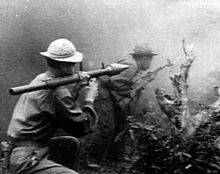
North Vietnamese troops with RPG-2 (B-40), 1968.
More Soviet tech - Soviet MIG's in North Vietnam
Mig-17 / NVAF - This deadly Russian fighter earned the respect of U.S. pilots in the war-torn skies over Vietnam. Flown by North Vietnamese pilots, the MiG-17 boasted excellent maneuverability and a heavy cannon armament.
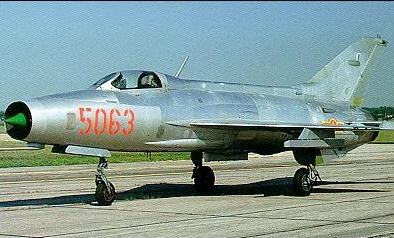
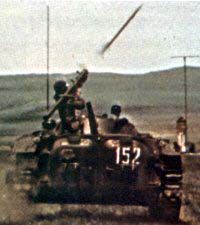
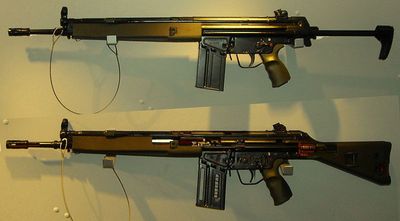
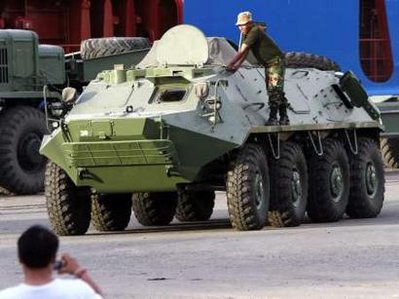
By Sea, Air, and Land: An Illustrated History of the U.S. Navy and the War in
Southeast Asia
http://www.history.navy.mil/seairland/index.html
Without the material support from the Soviets the Vietnam war would have
been over in a year, instead the ships continued into Haiphong harbour
for the next ten years till "they" decided that the U.S.A. had been
beaten into submission .... Years later the Soviets would get the same treatment
in Afghanistan.... Making China relatively stronger (with the tech transfers for
ICBM's from Loral Corp...) so that today China appears the military equal
to the U.S.A. ....
Loral
pleaded no contest to a long list of U.S. national security violations,
including the unauthorized transfer of missile guidance technology to the
Chinese army.
Notice here also how they always include China with the Soviets like it was
equal amounts, when 90 percent of the war materials were from the Soviets.
I have tried to document the amount of real support China gave to Vietnam and it
seems to boil down to the "threat" of their troops pouring south like
they did in Korea....
Historical
dictionary of the 1970s By James Stuart Olson
Haiphong harbour
During the Vietnam War Large volumes of military supplies from the Soviet
Union and the Peoples Republic of China arrived through Haiphong...
Both LBJ and Nixon refused to mine Haiphong Harbor ... [ that would end
the material supply line from the Soviets] ... .... USA risked injuring
Soviet or Chinese civilians AND Miltary personnel.....
Some interesting photos:
http://www.talkingproud.us/Military/page111/page114/EarthquakeMcGoonCIA.html
James B. McGovern, transport pilot, Civil Air Transport, CIA, Vietnam, 1950s.
...
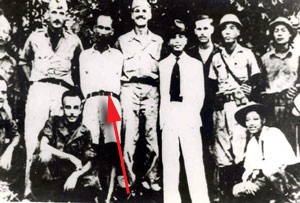
Ho Chi Minh (noted by red arrow) receives American secret servicemen in a
special unit nicknamed "The Deer"
http://www.talkingproud.us/Military/page111/page114/EarthquakeMcGoonCIA.html
...
Without going too deeply into this fascinating history,
the Office of Strategic
Services (OSS), the predecessor to CIA, had sent agents into China during WWII.
Among many other things, while there,
they befriended a
Vietnamese communist guerrilla, Ho Chi Minh. Ho became a strong ally of the US
in the fight against the Japanese,
and against the French Vichy government that was running Indochina.
Indeed, Ho's Viet Minh army was helping downed US pilots in Indochina.
...
In 1945, President Truman gave France his approval to resume colonial
authority over Indochina.
The Japanese had thrown the French out in 1945. But, the Japanese surrendered in
September 1945. Ho declared independence.
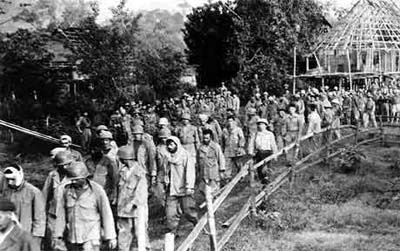
French prisoners being marched by Viet Minh out of Dien Bien Phu, May
7, 1954.
David Milne. America's Rasputin: Walt Rostow and the Vietnam War. New
York: Hill and Wang, 2008. 336 pp. $26.00 (cloth), ISBN 978-0-374-10386-6.
http://www.h-net.org/reviews/showrev.php?id=24172
Reviewed by Richard Verrone (Texas Tech University)
Published on H-War (March, 2009)
Commissioned by Janet G. Valentine
JFK's and LBJ’s True Believer
Of all the advisors that graced the West Wing of the White House during the John
F. Kennedy and Lyndon B. Johnson years, Walt Whitman Rostow was, according to
author David Milne, the truest and most fervent hawk. He was also
a reverent Cold War ideologue who believed in the power of the U.S.
military in spreading American-style democracy. Milne, a lecturer in
American politics and foreign policy at the University of East Anglia, casts
longtime national security advisor to JFK and LBJ, Walt Rostow, as a man of
great intellect and powerful persuasiveness who was able to gain the ear of his
boss, the president of the United States, particularly LBJ. Because of this,
Rostow had his version of how to counter the Soviet Union, defeat the
Democratic Republic of Vietnam, and win the war in Vietnam implemented. In
the insightful America’s Rasputin, Milne explains Rostow's diplomatic and
military ideology when it came to fighting communism around the world,
particularly in the third world, and lays at his feet much of the direct
responsibility for the U.S. debacle in Southeast Asia..
America’s Rasputin is essentially a brief biography of Rostow that traces his
roots from Flatbush, Brooklyn, New York to Washington, D.C. The book is
organized into eight chapters and an epilogue, and presents a chronological
rendering of Rostow's life. The majority of the book is dedicated to his
Washington and White House years, first as Kennedy's deputy assistant for
national security affairs (1961-62), and then as Johnson's national security
advisor from 1966 to 1969 (replacing McGeorge Bundy and Robert Komer). In
between, Rostow did time as a member of the State Department's Policy Planning
Council, but still had immediate access to the president.
The title of Milne's book comes from a comment made about Rostow by Averell
Harriman, one of America's most celebrated diplomats. Harriman described
Rostow as "America's Rasputin," comparing him to the Russian mystic
who advised Russian czar Nicholas II, for the powerful and sometimes unsavory
influence Rostow exerted on JFK and LBJ's presidential decision making. Despite
this label, Rostow brought to the table tremendous intellectual capability.
He was a product of the best of academia--Yale, Oxford (as a Rhodes
Scholar), and MIT (as a professor of economic history). But, Rostow also brought
a strict, immovable ideology of anti-communism that was honed through his early
years in academia and the McCarthy era, the Korean War, and the Eisenhower
administration. He believed that capitalism would eclipse communism in the
battle for economic supremacy, and that the ultimate defeat of the Soviet Union
would begin from the successful battle for the third world, although not
necessarily in a direct confrontation between the two powers. Rostow's
1960 book, The Stages of Economic Growth: A Non-Communist Manifesto, was
to him a complete refutation of Marxian ideology. In it, he stated that
underdeveloped nations needed significant assistance from the United States to
reach a prosperous and effective capitalist democracy. That assistance
could come in the economic form, as well as the diplomatic and military form.
The emphasis, however, was on economic aid. After Kennedy's
assassination, and Johnson's ascendency to the presidency, Rostow became
increasingly influential in national security policymaking, particularly in
decisions about the Vietnam War.
Milne leaves the reader with the distinct impression that Rostow not
only had far too much influence on West Wing decisions, but that the influence
he exerted came from beliefs about how the United States should interact with
the Cold War world that were far from a consensus ideology. As "the
most hawkish civilian member of the Kennedy and Johnson administrations,"
Rostow was the first to advise Kennedy to send U.S. combat troops to South
Vietnam, and the first to recommend the bombing of North Vietnam (p. 6). This
was but one example put forth by Milne of Rostow as a man full of
contradictions. His work outside of government before becoming a member of
Kennedy’s national security team argued that the United States needed to
assist developing nations economically, not militarily, and that this was the
best path to eventual democracy and alliance with the United States. To
this end, Kennedy formed two large-scale aid programs which were in line with
the Rostowian ideology of American assistance to developing nations, the Agency
for International Development (USAID) and the Alliance for Progress (directed at
Latin America). Yet,over time, he became the framer of the largest
American military escalation in a developing country (Vietnam) which the United
States hoped to bring to its side in the Cold War. To Rostow, if a country
(or part of one in Vietnam's case) was communist, then that country would be
shown no mercy if it engaged the U.S. militarily. He believed that
eliminating the enemy's capability to wage war by destroying factories, power
plants, and logistical networks was the best avenue to victory. Thus, he
championed massive escalatory strategic bombing of North Vietnam, much like the
bombing of the Axis powers in World War II, to bring quicker resolution to the
conflict. In Kennedy, Rostow did not have a president who would fully
unleash the American arsenal on its enemies, but in Johnson, he had a president
who put most all options on the table, and who ultimately endorsed Rostow's
strategy. In order to get that accomplished, Milne states that because of
his ability to persuade as well as his extreme confidence in himself and his
beliefs, Rostow had Johnson’s ear. Rostow said what Johnson wanted to
hear, and said it at the right time. According to the author, Rostow's two
biggest contributions to the war in Vietnam, were: first, that he persuaded LBJ
to implement, and then continue, the graduated bombing of North Vietnam; and
second, that he advised LBJ against pursuing a compromise peace with North
Vietnam, thus extending the war's duration
Milne gives the reader a good view of Rostow's strengths (his intelligence,
persuasiveness, and governmental experience) and weaknesses (his overconfidence
and refusal to compromise). Rostow's unwavering belief in his own polemics
and his incredible overconfidence, coupled with his refusal to modify his ideas
based on alternative perspectives, were, in Milne's estimation, not just
self-deluding, but reckless at best, and outright dangerous at worst. Milne
skillfully demonstrates that Rostow had very little understanding of Southeast
Asian political or cultural history, and was analytically deficient in
perceiving the conflict as a nationalist civil war first, and a war between
communism and a fledgling democracy second. The fact that Rostow could
consistently convince LBJ to follow a certain policy path, when others could
not, made Rostow one of the most important individuals associated with the
Vietnam War and the ultimate American defeat. His influence and
contribution, the author believes, was easily as important as that of
McGeorge Bundy, Robert McNamara, or Dean Rusk. As for being
"America's Rasputin," Milne ultimately finds that Harriman's view on
Rostow was correct, that his advice was an overwhelmingly negative factor in
American foreign policy decisions concerning Vietnam between 1960 and 1969.
However, one also has to fault LBJ for allowing a person with Rostow's
personality to have so much sway in policy making. By the same token,
Milne contends in chapter 6 that LBJ appointed Rostow as national security
advisor in 1966 partly because he wanted to send an unambiguous message, both at
home and abroad, that a harder American military approach was necessary in
Vietnam, and that the United States intended to win in Southeast Asia
Milne's prose is very readable, and absent of jargon. He takes what could
be a complicated subject, and presents it clearly. The work is well
documented; Milne's 33 pages of notes complement 256 pages of text. The
notes are divided equally between primary sources (mainly personal papers from
the JFK and LBJ Presidential Libraries) and secondary sources (primarily
monographs and memoirs written by the key players in Washington). One of
the notable strengths of the work is the author's use of no fewer than
thirty-one oral history interviews conducted with a variety of people who had
access to, or knew Rostow. Milne's bibliography is thorough, and
demonstrates a good knowledge of the existing literature on Rostow, Washington,
and American foreign policy in the 1960s, as well as the important individuals
who made, or influenced, American policy in Southeast Asia. America's
Rasputin belongs on the shelf of all university libraries, as well as any
scholar or instructor of the period, especially those who teach the Vietnam War.
| - - - -
The above author compares that warmonger to Wolfowitz exposing another
similarity to the illegal warpath we are still on...
Article
http://www.uea.ac.uk/psi/People/Academic/David+Milne
Milne, David (2010) America's Intellectual Diplomacy. International Affairs,
86(1).
Milne, David (2009) Wilson Agonistes: The Battle for Woodrow Wilson. The Nation.
Milne, David (2008) Which Hotshots Will Head to DC? Los Angeles Times.
Milne, David (2007) Intellectualism in American Diplomacy: Paul Wolfowitz and
his Predecessors. International Journal.
Milne, David (2007) The Paul Wolfowitz of the 1960s. Los Angeles Times.
Milne, David (2007) The Peculiar Career of Walt Whitman Rostow. Vietnam
Magazine.
Milne, David (2007) Our Equivalent of Guerrilla Warfare: Walt Rostow and the
Bombing of North Vietnam, 1961-1968. Journal of Military History, 71.
The
Pentagon Papers ...
A 1996 article in the New York Times said that the Pentagon Papers
"demonstrated, among other things, that the Johnson
Administration had systematically lied, not only to the public but also
to Congress, about a subject of transcendent national interest and significance
...
In February 1971 Ellsberg discussed the study with New York Times reporter
Neil Sheehan, and gave 43 of the volumes to him in March. The Times began
publishing excerpts on June 13, 1971; the first article in the series was
titled "Vietnam Archive: Pentagon Study Traces Three Decades of Growing
US Involvement". The name "Pentagon Papers" for the study
arose during the resulting media publicity.[3][4] Street protests, political
controversy and lawsuits followed.
...
The Papers revealed that the U.S. had deliberately expanded its war with bombing
of Cambodia and Laos, coastal raids on North Vietnam, and Marine Corps attacks,
none of which had been reported by media in the US.[7]
The most damaging revelations in the papers revealed that four
administrations, from Truman
to Johnson, had misled the public regarding their intentions. For
example, the John F. Kennedy administration had planned to overthrow South
Vietnamese leader Ngo Dinh Diem before his death in a November 1963 coup. President
Johnson had decided to expand the war while promising "we seek no wider
war" during his 1964 presidential campaign,[3] including plans to bomb
North Vietnam well before the 1964 Election. President Johnson had been
outspoken against doing so during the election and claimed that his opponent
Barry Goldwater was the one that wanted to bomb North Vietnam.[8]
September 16, 2011
COMPLETE PENTAGON PAPERS AT LAST! All Three Versions Posted, Allowing
Side-by-Side Comparison
for reference:
Mao
was a Yale Man - A Yali for Skull and Bones
China
Spying - Technology Transfers
Former
US diplomat exposes how US actually helped communist China instead of KMT
THE
FORTY YEARS WAR - Nixon gave up Vietnam
Genocide
against the Serbs
http://www.cato-at-liberty.org/the-good-news-and-bad-news-about-sneakers-on-the-ground/
The Good News and Bad News about ‘Sneakers on the Ground’ Posted by
Justin Logan
There is good news and bad news about the report that the Obama
administration authorized CIA teams to go into Libya to liaise with the
Libyan opposition before instituting a no-fly zone over that country. (The
phrase “sneakers on the ground” has emerged in response to the
administration’s firm insistence that there are no US boots on the ground
there.)
...
http://daphnecaruanagalizia.com/2011/03/31/sneakers-on-the-ground/
Published: March 31, 2011 at 2:30am The New York Times
U.S. AGENTS ARE IN LIBYA, AIDING STRIKES AND MEETING REBELS
By MARK MAZZETTI and ERIC SCHMITT
Published: March 30, 2011
WASHINGTON — The Central Intelligence Agency has inserted clandestine
operatives into Libya to gather intelligence for military airstrikes and
contact rebels battling Col. Muammar el-Qaddafi’s forces, according to
American officials.
While President Obama has insisted that no American military ground troops
participate in the Libyan campaign, small groups of C.I.A. operatives have
been working in Libya for several weeks as part of a shadow force of Westerners that
the Obama administration hopes can help bleed Colonel Qaddafi’s military, the
officials said.
In addition to the C.I.A. presence, composed of an unknown number of
Americans who had worked at the spy agency’s station in Tripoli and others
who arrived more recently, current and former British officials said that
dozens of British special forces and MI6 intelligence officers are working
inside Libya. The British operatives have been directing airstrikes from
British jets and gathering intelligence about the whereabouts of Libyan
government tank columns, artillery pieces and missile installations, the
officials said.
United States officials hope that similar information gathered by American
intelligence officers — from the location of Colonel Qaddafi’s munitions
depots to the clusters of government troops inside towns — might help
weaken Libya’s military enough to encourage defections within its ranks.
In addition, the American spies are meeting with rebels to try to fill in
gaps in understanding who their leaders are and the allegiances of the
groups opposed to Colonel Qaddafi, according to United States government
officials, speaking on condition of anonymity because of the classified nature
of the activities. American officials cautioned, though, that the Western
operatives
...
http://www.talkingproud.us/Military/page111/page114/EarthquakeMcGoonCIA.html
Earthquake McGoon - OSS - CIA - James B. McGovern Jr.
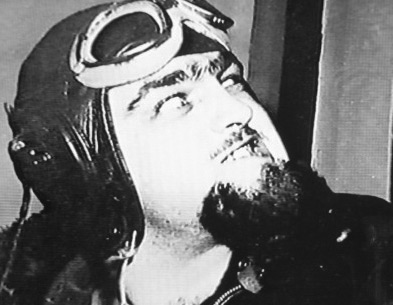
"His 300 pounds shake the earth when he walks, Yet he soars with the
grace of a loon;
The legend makes claim that this beast from the East. Is known as Earthquake
McGoon."
The first American to die in combat in Vietnam - James B. McGovern Jr. - May 6,
1954,
Notice he is "identified" Sept 11'th - 9/11:
http://www.msnbc.msn.com/id/15335924/
Earthquake McGoon’ finally flying home - 10/19/2006
Remains of legendary pilot killed 52 years ago being returned to family
NEW YORK — More than half a century after he died in the flaming
crash of a CIA-owned cargo plane and became one of the first two Americans to
die in combat in Vietnam, a legendary soldier of fortune known as “Earthquake
McGoon” is finally coming home.
The skeletal remains of James B. McGovern Jr., discovered in an unmarked
grave in remote northern Laos in 2002, were positively identified on Sept.
11 by laboratory experts at the U.S. military’s Joint POW/MIA Accounting
Command in Hawaii
...
Six feet and 260 pounds — huge for a fighter pilot — McGovern carved out a
flying career during and after World War II that made him a legend in Asia. An
American saloon owner in China dubbed him “Earthquake McGoon,” after a
hulking hillbilly character in the comic strip “Li’l Abner.”
He died on May 6, 1954, when his C-119 Flying Boxcar cargo plane was hit by
ground fire while parachuting a howitzer to the besieged French garrison at Dien
Bien Phu. “Looks like this is it, son,” McGovern radioed another pilot as
his crippled plane staggered 75 miles into Laos, where it cartwheeled into a
hillside.
Killed along with “McGoon,” 31, were his co-pilot, Wallace Buford, 28,
and a French crew chief. Two cargo handlers, a Frenchman and a Thai, were
thrown clear and survived.
| - - - - - -
Notice the comparison to John Belushi in the film "1941" in
character as Captain "Wild Bill Kelso"
